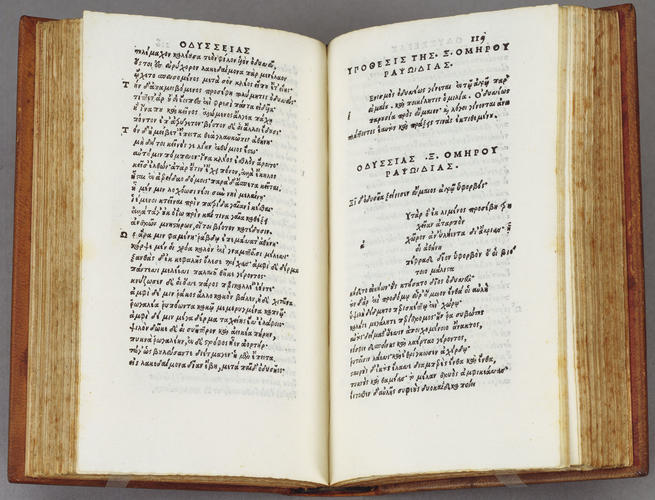-
1 of 253523 objects
Odyssey 1524
16 cm (Height) x 3.5 cm (Depth) (book measurement (conservation)) | RCIN 1081184
-
Homer's Odyssey was one of the most popular classical works printed during the Renaissance. Along with the Iliad, it is one of the earliest surviving pieces of Western literature. It tells the story of the ten-year voyage of Odysseus, who is constantly driven off course from his return to Ithaca by a vengeful Poseidon, following the destruction of the city of Troy.
This edition is one of the ground-breaking octavo editions of the Odyssey, using the last, smallest and clearest of Aldus Manutius’s four Greek fonts. Aldus’s aim was to save the Greek classics from loss by printing editions available to all, and from the 1490s began producing printed copies of such works as Aristotle, Aristophanes, Sophocles and Herodotus. His fonts were based on calligraphic examples provided by Greek natives from Crete, who also acted as compositors and proof readers. By the time of his death in 1515 he had firmly established the printing of Greek editions in Venice.
Binding information
Two volumes bound by Pietro Francese, both bound in red calf with gold tooling of knotwork design and foliate crest with title to centre OMHPOY IAIAΣ (first vol) OMHPOY OΛYΣ (second vol), inside unusual roll tool border frame of oblongs and crosses. Each volume differentiated in interior corners of frame by differing tools of leaf design. Both volumes rebacked with new spine, original front and back covers pasted on new boards. All edges gilt and gauffered.Provenance
Acquired for the Royal Library at Wilkinson's sale, July 1836, Lot 304.
-
Creator(s)
Acquirer(s)
-
Measurements
16 cm (Height) x 3.5 cm (Depth) (book measurement (conservation))
16.0 x 3.5 cm (book measurement (inventory))
Category
Other number(s)
Alternative title(s)
Homeri Odysseia (Works of Homer; v. 2)
[Odyssey]. Greek
Place of Production
Venice [Veneto]
